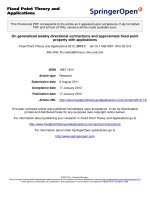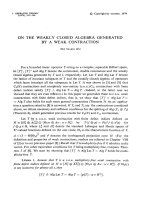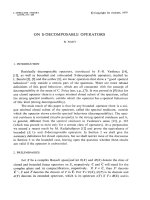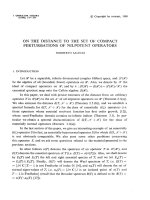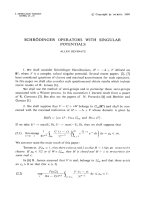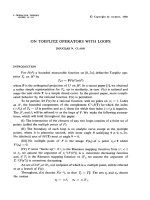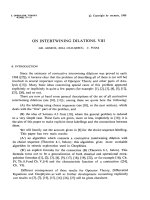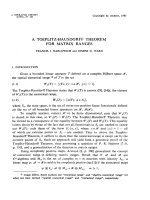Báo cáo toán học: "On hypergraphs with every four points spanning at most two triples" ppsx
Bạn đang xem bản rút gọn của tài liệu. Xem và tải ngay bản đầy đủ của tài liệu tại đây (67.57 KB, 4 trang )
On hypergraphs with every four points
spanning at most two triples
Dhruv Mubayi
Department of Mathematics, Statistics, and Computer Science,
University of Illinois,
Chicago, IL 60607
∗
Submitted: Jan 10, 2003; Accepted: Aug 25, 2003; Published: Sep 8, 2003
MR Subject Classifications: 05C35, 05C65, 05D05
Keywords: Hypergraph Tur´an numbers
Abstract
Let F be a triple system on an n element set. Suppose that F contains more
than (1/3 − )
n
3
triples, where >10
−6
is explicitly defined and n is sufficiently
large. Then there is a set of four points containing at least three triples of F.This
improves previous bounds of de Caen [1] and Matthias [7] .
Given an r-graph F,theTur´an number ex(n, F) is the maximum number of edges in an
n vertex r-graph containing no member of F.TheTur´an density π(F) = lim
n→∞
ex(n,F )
(
n
r
)
.
When π(F) =0,andr>2, determining π(F) is a notoriously hard problem, even for
very simple r-graphs F (see [5] for a survey of results). Determining the Tur´an density
of complete r-graphs is a fundamental question about set-systems. In fact, this is not
known in any nontrivial case when r ≥ 3.
Perhaps the most well-known problem in this area is to determine π(K), where K is
the complete 3-graph on four vertices (the smallest nontrivial complete r-graph). It is
known that 5/9 ≤ π(K) ≤ (3 +
√
17 )/12 = 0.59359 , where the lower bound is due
to Tur´an and the recent upper bound is due to Chung and Lu [2]. However, even the
Tur´an density of H(4, 3), the 3-graph on four vertices with three edges, is not known.
One could argue that this problem is even more basic, since H(4, 3) is the smallest (in the
sense of both vertices and edges) 3-graph with positive Tur´an density (for applications of
π(H(4, 3)) to computer science, see [9, 6]).
∗
Research supported in part by the National Science Foundation under grant DMS-9970325
the electronic journal of combinatorics 10 (2003), #N10 1
The upper bound π(H(4, 3)) ≤ 1/3 was proved by de Caen [1], and this was improved
to 1/3 −10
−10
by Matthias [7]. Frankl and F¨uredi [4] gave a fairly complicated recursive
construction yielding π(H(4, 3)) ≥ 2/7. In an attempt to improve de Caen’s bound,
the author and R¨odl [8] proved that π({C
5
,H(4, 3)}) ≤ 10/31, where C
5
is the 3-graph
123, 234, 345, 451, 512.
In this note, we present a short argument that improves the best upper bound slightly.
Theorem 1 π(H(4, 3)) ≤ 1/3 −(0.45305 × 10
−5
).
Proof: Let H be a triple system on n vertices containing no copy of H(4, 3). Suppose
that H has α
n
3
edges. We will prove that α ≤ 1/3 −(0.45305 ×10
−5
)+o(1). The result
then follows by taking the limit as n →∞.
Let d
x,y
denote the number of triples containing both x and y.Fori =1, 2, let q
i
denote the number of sets of four vertices that induce exactly i edges. Then
α
n
3
(n −3) = |H|(n −3) = q
1
+2q
2
and
x,y
d
x,y
2
= q
2
.
Using these equalities,
x,y
d
x,y
=3α
n
3
, and convexity of binomial coefficients, we obtain
α
n
3
(n −3) ≥ q
1
+3α
2
n
3
(n −2) −3α
n
3
. (1)
Since q
1
≥ 0, dividing (1) by n
4
and taking the limit as n →∞gives de Caen’s bound
α ≤ 1/3.
The improvement arises by proving that a positive proportion of quadruples contribute
to q
1
. By (1) this immediately lowers the bound of 1/3. Our primary tool is a result of
Frankl and F¨uredi [4] stating that every m vertex triple system, m ≡ 0 (mod 6), such that
every four points span 0 or 2 edges, has at most 10(m/6)
3
edges (their result is quite a bit
stronger, but this version suffices for our purposes). We will use this on subhypergraphs
of H to lower bound q
1
. This technique, called supersaturation, was developed by Erd˝os
and Simonovits [3] (although frequently used in earlier papers as well).
Claim: Suppose that δ>0and12≤ m ≡ 0 (mod 6) satisfy
δ(m
2
− 6m)
18(m −1)(m − 2)
+
5m
2
18(m −1)(m − 2)
≤ α. (2)
Then at least δ
n
m
sets of m vertices of H have greater than 10(m/6)
3
edges.
ProofofClaim: Otherwise, using the precise upper bound of [1] which states that
ex(m, H(4, 3)) ≤ (m/(3(m − 2))
m
3
(< 10(m/6)
3
for m ≥ 12), we obtain
|H| <
δ
n
m
m
3(m−2)
m
3
+(1− δ)
n
m
10(m/6)
3
n−3
m−3
≤ α
n
3
.
This contradiction proves the Claim.
the electronic journal of combinatorics 10 (2003), #N10 2
For each m-set S to which the Claim applies, [4] implies that S contains a 4-element
set with precisely one edge. Consequently,
q
1
≥
δ
n
m
n−4
m−4
=
δ
m
4
n
4
.
Using this lower bound in (1) yields
α
n
3
(n −3) ≥
δ
m
4
n
4
+3α
2
n
3
(n −2) −3α
n
3
.
Dividing by n
n
3
and taking the limit as n →∞we get
α ≥
δ
4
m
4
+3α
2
.
Choose m =18andδ =68α/3 −15/2. Then (2) is satisfied (with equality) and therefore
α ≥
136α
(18)
4
−
45
(18)
4
+3α
2
.
Solving this quadratic, we obtain α ≤ 0.3333288028 = 1/3 −(0.45305 × 10
−5
).
Remarks:
• In order to simplify the presentation, we have not optimized the constants in the proof.
Moreover, the upper bound is certainly far from being sharp. The value of Theorem 1
lies only in presenting a short proof that improves the previous best upper bound for this
basic problem.
• It is mentioned in [4] that Erd˝os and S´os made the following conjecture: if H is an n
vertex 3-graph where N(x)={yz : xyz ∈H}is bipartite for every vertex x,then|H| <
n
3
/24. There exist triple systems H satisfying this property with |H| > (1/4 − o(1))
n
3
,
so Erd˝os and S´os’ conjecture, if true, would be asymptotically sharp. Since H(4, 3) has a
vertex x where N(x) is a triangle, |H| ≤ ex(n, H(4, 3)). As far as we know, this is the best
known upper bound for H. Thus Theorem 1 improves the upper bound for this problem
as well.
Conjecture 2 For infinitely many n, the construction from [4] has the most edges among
n vertex triple systems with no copy of H(4, 3). In particular, π(H(4, 3)) = 2/7.
Acknowledgments
I thank Z. F¨uredi and a referee for informing me about [7].
the electronic journal of combinatorics 10 (2003), #N10 3
References
[1] D. de Caen, Extension of a theorem of Moon and Moser on complete subgraphs, Ars
Combinatoria 16 (1983) 5–10.
[2] F. Chung, L. Lu, An Upper Bound for the Tur´an Number t
3
(n, 4),J.Combin.Theory
Ser. A 87 (1999), 381–389.
[3] P. Erd˝os, M. Simonovits, Supersaturated graphs and hypergraphs, Combinatorica,
3, (1983), 181–192.
[4] P. Frankl, Z. F¨uredi, An exact result for 3-graphs. Discrete Math. 50 (1984), no. 2-3,
323–328.
[5] Z. F¨uredi, Tur´an type problems. Surveys in combinatorics, 1991 (Guildford, 1991),
253–300, London Math. Soc. Lecture Note Ser., 166, Cambridge Univ. Press, Cam-
bridge, 1991.
[6] Z. F¨uredi, R. H. Sloan, K. Takata, Gy. Tur´an, On set systems with a threshold
property, submitted.
[7] U. Matthias, Hypergraphen ohne vollst¨andige r-partite Teilgraphen (Doctoral Thesis,
Heildelberg, 1994).
[8] D. Mubayi, V. R¨odl, On the Tur´an number of triple systems, Journal of Combinato-
rial Theory, Ser. A, 100, (2002), 136–152.
[9] R. H. Sloan, K. Takata, Gy. Tur´an, On frequent sets of Boolean matrices, Annals of
Math. and Artif. Int. 24 (1998), 193-206.
the electronic journal of combinatorics 10 (2003), #N10 4

